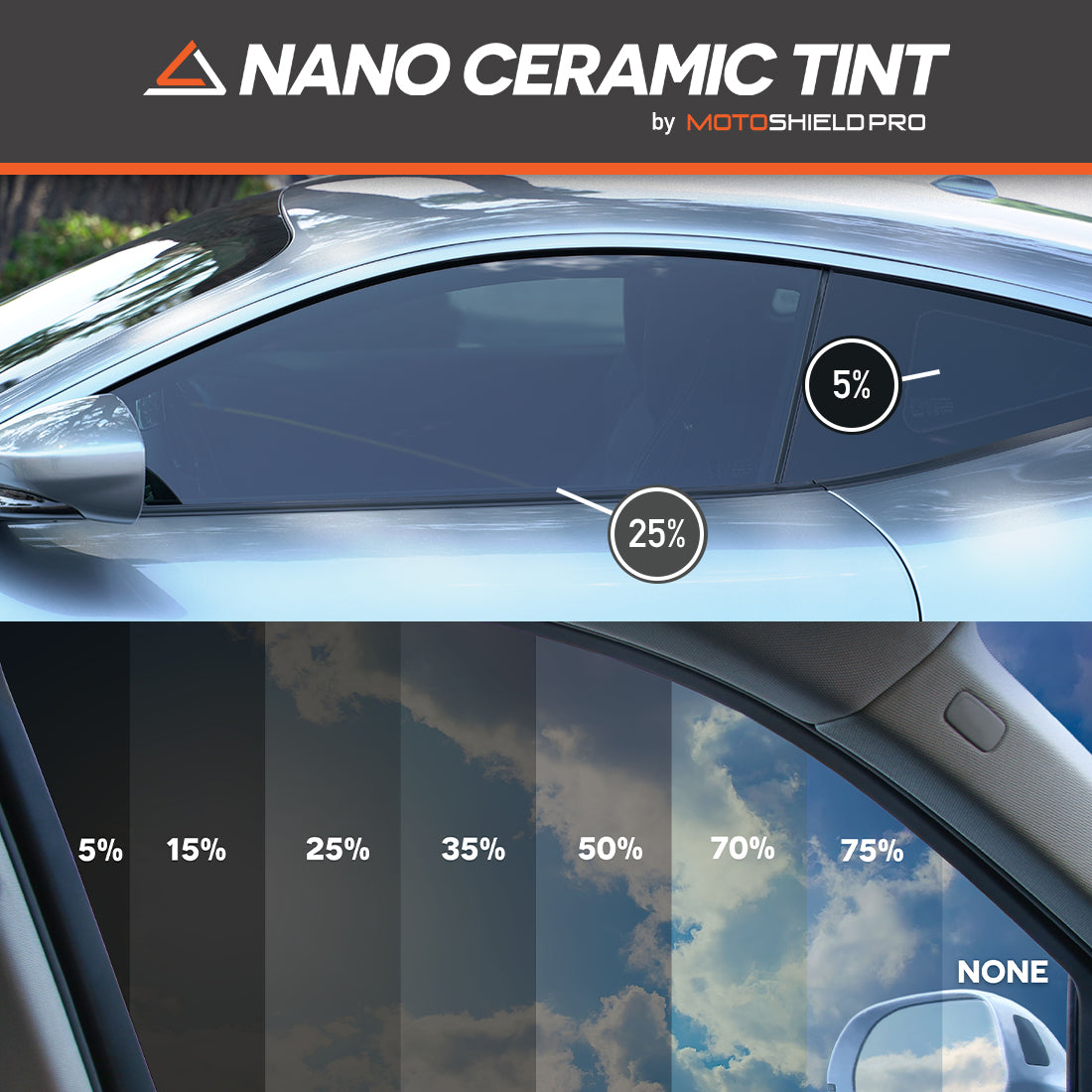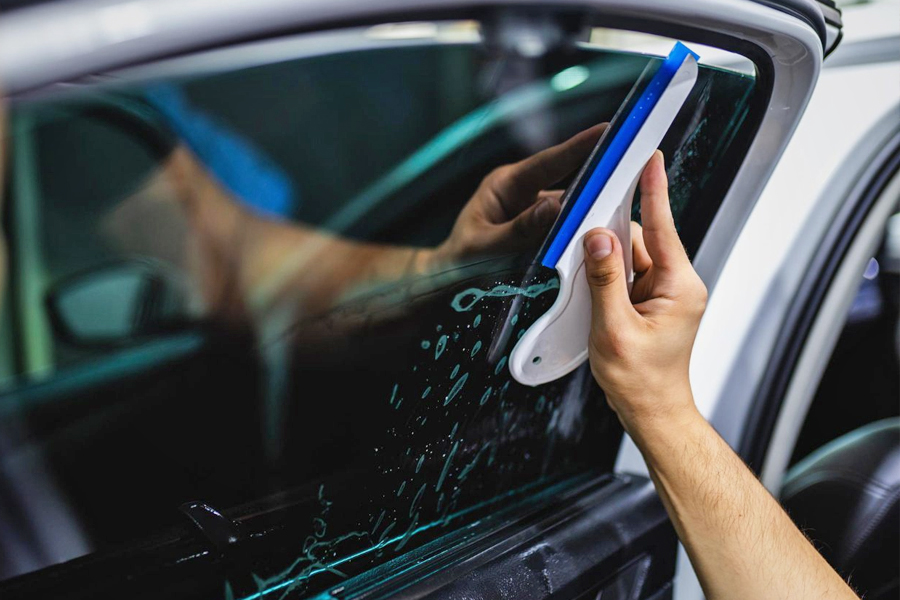A Comprehensive Overview to Understanding Automobile Window Tint and Its Advantages
Car window tinting serves more than simply a visual objective for vehicles. It provides various kinds, each with unique functions and advantages. Recognizing these choices, along with lawful guidelines and maintenance tips, is important for any kind of automobile owner. The benefits may significantly enhance driving convenience and automobile durability. As one checks out the subtleties of window tinting, the question emerges: what kind of color is ideal matched for private needs?
Recognizing Car Window Tint: What It Is and Just how It Works
Auto home window color serves as a protective obstacle that boosts vehicle aesthetic appeals while giving practical advantages. This thin movie is used to the indoor surface area of automobile windows, reducing glow and obstructing dangerous ultraviolet (UV) rays from the sunlight. By filtering system sunshine, vehicle window color helps to control the indoor temperature of the car, resulting in increased comfort for guests and decreased dependence on air conditioning.Additionally, it protects the lorry's inside from fading, maintaining both furniture and control panel products. The color can likewise enhance personal privacy, making it harder for outsiders to see inside the vehicle. Moreover, certain sorts of window color can raise safety; in case of a crash, the film helps hold shattered glass with each other, decreasing the risk of injury from flying shards. On the whole, automobile home window color offers both sensible and visual objectives, making it a prominent option amongst automobile owners.
Kinds Of Window Tint: A Summary of Options
When thinking about window tint alternatives, numerous types are available, each with distinctive qualities. Dyed, metalized, and ceramic window colors offer varying degrees of warmth rejection, UV defense, and visual allure. Comprehending these differences can assist car owners make educated choices based upon their requirements and preferences.
Dyed Home Window Tint
Colored window color stands for a preferred option among car proprietors seeking a affordable and reliable method to enhance their vehicle's looks and personal privacy. This sort of color is created by positioning a layer of dye in between a protective finishing and an adhesive layer, causing a darkened appearance that lowers glare and boosts visual convenience. While dyed window color efficiently obstructs unsafe UV rays, it might not offer the exact same level of heat being rejected as other color kinds. Furthermore, its shade can discolor gradually, potentially reducing its effectiveness. In spite of these drawbacks, dyed window color remains popular for its cost-effectiveness and ability to offer a streamlined, trendy want to different lorry models.
Metalized Window Tint
Metalized home window color supplies an equilibrium of design and capability, making it a popular choice among automobile proprietors. This type of tint includes metal bits within the movie, boosting both visual allure and heat rejection. The reflective high quality of metalized tint helps to lower glow and improve personal privacy, while also supplying UV protection, which safeguards the vehicle's interior. In addition, metalized home window color can strengthen window strength, possibly preventing shattering during crashes. It is crucial to note that the metal elements can interfere with digital signals, such as General practitioner and cell phone reception. Overall, metalized window tint supplies an efficient solution for those looking for a mix of look, sun, and durability defense for their lorries.
Ceramic Home Window Color
Ceramic home window tint represents an advanced alternative in the spectrum of auto window films, using distinctive benefits over standard colors. Unlike colored or metalized films, ceramic tints utilize sophisticated ceramic fragments, which successfully reject warmth and UV rays without endangering presence. This innovation guarantees that lorries stay cooler, reducing reliance on cooling and improving fuel efficiency. In addition, ceramic window tints are much less most likely to interfere with electronic tools, such as GPS or mobile signals, making them a practical option for modern-day vehicles. Their durability and scratch resistance contribute to a much longer lifespan compared to other kinds of colors. On the whole, ceramic window tint offers premium efficiency, comfort, and security, making it a preferred option for discerning automobile proprietors.
Advantages of Automobile Window Color: Beyond Looks
While numerous individuals associate vehicle window tint with boosted design, its advantages prolong much past simple aesthetic appeals. One substantial benefit is warm reduction; window color can obstruct as much as 99% of unsafe UV rays, maintaining the indoor cooler and safeguarding furniture from fading. This not just boosts convenience during heat yet additionally decreases reliance on air conditioning, leading to improved gas efficiency.In addition, car window color supplies an included layer of personal privacy and security. Colored windows make it challenging for outsiders to see inside the vehicle, which can hinder theft and protect valuables. In addition, numerous tints reinforce the glass, reducing the probability of ruining in case of an accident, therefore improving safety.In enhancement to these useful advantages, auto window color can also add to glare reduction, improving exposure for guests and chauffeurs alike. This multifaceted technique to comfort and security makes home window color a beneficial financial investment for automobile proprietors.
Lawful Considerations: Tinting Laws by State
Prior to committing to auto window color, lorry owners must navigate a complex landscape of tinting regulations that vary by state. Each state has details legislations regulating the permissible degrees of color darkness and reflectivity for different home windows, including windscreens, front side home windows, and rear home windows. These regulations usually include visible light transmission (VLT) percentages, which dictate exactly how much light can go through the colored glass.Some states permit darker colors on back windows while restricting front side and windscreen colors for security reasons. Furthermore, certain states may need a certificate from the supplier to verify compliance with tinting legislations. Going against these regulations can result in fines, obligatory removal of the tint, or both. As a result, it is crucial for vehicle owners to research their state's legislations completely to ensure lawful conformity before setting up window tint. This persistance can conserve time and cash in the lengthy run.
Picking the Right Tint: Factors to Consider
When choosing the proper home window color for a car, several vital elements enter play. Color darkness levels, UV defense rankings, and compliance with lawful policies are crucial factors to consider to assure both appearances and capability. Reviewing these elements will certainly aid people make an educated choice that satisfies their requirements and sticks to neighborhood legislations.
Tint Darkness Degrees
Picking the ideal tint darkness degree is important for achieving the desired equilibrium in between aesthetic appeals and performance in auto window tinting. Various states have differing legal guidelines regarding color darkness, which can influence the option. Usually, tints are determined in portions, with reduced percents suggesting darker tones. Darker tints supply enhanced privacy and a sleek appearance yet can reduce visibility, particularly in the evening. Conversely, lighter colors keep a more open feeling, making certain adequate exposure while still offering some heat and glare reduction. People should consider their driving behaviors, regional regulations, and individual choices when deciding. Inevitably, the best tint darkness degree improves the car's look while making sure safety and conformity with legal standards.
UV Security Score
Tint darkness degrees play a substantial role in the total efficiency of automobile window tinting, however one more important factor to examine is the UV protection score of the selected color. This score suggests the percentage of harmful ultraviolet rays that the color can obstruct. High-quality colors often supply 99% or even more UV protection, protecting passengers and the automobile's inside from sunlight damages. Davinci of Michigan. Extended exposure to UV rays can cause skin troubles and fading of furniture, making a high UV defense ranking essential for health and longevity. When selecting home window color, customers need to prioritize this ranking along with darkness degrees to assure optimum convenience and security while driving. Comprehending these elements aids in making an educated choice when spending in vehicle home window tinting
Lawful Laws Compliance
Comprehending regional lawful guidelines is essential for any individual taking into consideration vehicle home window tinting. Each state or region has particular legislations controling the permitted levels of tint darkness and reflectivity for different windows. These regulations frequently define the visible light transmission percentage, determining just how much light can pass with the tinted glass. Non-compliance can bring about fines, necessary removal of the color, or problems during vehicle examinations. Furthermore, some locations may have constraints on using particular tinting materials, requiring customers to choose items that meet security standards. It is crucial for vehicle owners to investigate their local legislations thoroughly before choosing home window color to guarantee compliance and stay clear of potential legal difficulties.

Installation Process: DIY vs. Professional Solutions
Exactly how does one make a decision in between a do it yourself installment and working with professional services for vehicle home window tinting? The choice frequently pivots on budget, experience, and desired outcomes. A do it yourself strategy can be economical, allowing people to save on labor expenses. Nevertheless, it needs a certain degree of ability and knowledge concerning the tinting process. Those who are precise and patient might discover success with DIY kits readily available in the market.Conversely, professional services provide expertise and top notch materials, making certain a perfect finish. Professionals often ensure their work, providing comfort against potential concerns such as peeling or gurgling. Furthermore, they recognize with neighborhood laws pertaining to tinting, which can be complicated for the typical automobile owner.Ultimately, the choice shows an equilibrium between price, personal capacity, and the expected quality of the tinting work. Each choice has its advantages, and the best selection depends on specific situations and choices.
Maintenance Tips: Maintaining Your Color in Top Problem

Frequently Asked Concerns
For How Long Does Window Tint Normally Last on a Vehicle?
Home window color generally lasts between 5 to 10 years, relying on elements such as top quality, application, and ecological conditions. Routine maintenance and correct care can expand its lifespan, making certain suitable efficiency and appearance gradually.
Can Window Tinting Damages My Vehicle's Original Glass?
Home window tinting, when used properly, does not harm a vehicle's initial glass. Improper installment or low-quality products might lead to issues like peeling off or gurgling, potentially impacting the glass's integrity over time.
Is Home Window Tinting Safe for All Types of Autos?
Window tinting is generally secure for the majority of cars, supplied the movie follows regional guidelines and is properly applied. Nevertheless, some customized lorries might require specific factors to consider, making it vital to consult experts prior to installation.
Will Window Tinting Gap My Auto Guarantee?
The concern of whether window tinting spaces an auto warranty commonly depends upon the producer's policies. Typically, if the tint does not damage the lorry, service warranties typically remain undamaged. Nonetheless, getting in touch with the supplier is a good idea.
Can I Get Rid Of Window Tint Myself if Needed?
Getting rid of window tint oneself is feasible, yet it needs careful focus to prevent harming the glass. Individuals should make use of proper tools and strategies to ensure a successful elimination without leaving adhesive deposit or scratches behind. While dyed home window tint successfully blocks hazardous UV rays, it may not offer the same degree of warm denial as various other tint kinds. Ceramic home window tint represents an innovative alternative in the spectrum of auto window movies, using unique benefits over traditional tints. Prior to dedicating to automobile home window color, automobile proprietors have to browse a complex landscape of tinting laws that vary by state. These guidelines typically consist read more of visible light transmission (VLT) portions, which dictate exactly how much light can pass via the tinted glass.Some states permit darker tints on back windows while limiting front side and windshield colors for safety reasons. Color darkness degrees play a considerable duty in the overall performance of auto window tinting, yet another crucial variable to evaluate is the UV security score of the picked color.